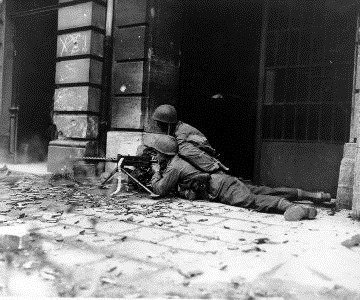95th Infantry Division

“Victory Division”
The division insignia consists of a monogrammatic red “9” and a white Roman “V” on a blue background. The roman “V” signifies the division nickname, “Victory Division”, and the Arabic “9” and Roman “V” represent the division’s number. The red, white, and blue colors parallel the colors of the American flag.
Known as the “Iron Men of Metz”
On 15 July 1942, the division was ordered into active military service and reorganized at Camp Swift, Texas. The 189th and 190th Infantry Brigades were disbanded as part of an army-wide elimination of infantry brigades. Instead, the division was based around three infantry regiments, the 377th Infantry Regiment, the 378th Infantry Regiment, and the 379th Infantry Regiment. Also assigned to the division were the 358th, 359th, 360th, and 920th Field Artillery Battalions, the 95th Signal Company, the 795th Ordnance Company, the 95th Quartermaster Company, the 95th Reconnaissance Troop, the 320th Engineer Battalion, the 320th Medical Battalion, and the 95th Counter-Intelligence Detachment. Major General Harry L. Twaddle took command of the division, a command he held for its entire duration in World War II, making him one of only eleven generals to do so. The division also received a Shoulder Sleeve Insignia this year. Over the next two years, the division trained extensively in locations throughout the United States.
The 95th Infantry Division was assigned to XIII Corps of the Ninth United States Army, Twelfth United States Army Group. The division sailed for Europe on 10 August 1944. The 95th Infantry Division arrived in England on 17 August. After receiving additional training, it moved to France one month later on 15 September. During this time it was reassigned to III Corps. The division bivouacked near Norroy-le-Sec, from 1 to 14 October. It was then assigned to XX Corps of the Third United States Army. The division was sent into combat on 19 October in the Moselle bridgehead sector east of Moselle and South of Metz and patrolled the Seillenear Cheminot, capturing the forts surrounding Metz and repulsing enemy attempts to cross the river. It was during the defense of this town from repeated German attacks that the division received its nickname, “The Iron Men of Metz.” On 1 November, elements went over to the offensive, reducing an enemy pocket east of Maizières-lès-Metz. On the 8 November, these units crossed the Moselle River and advanced to Bertrange. Against heavy resistance, the 95th captured the forts surrounding Metz and captured the city by 22 November.
The division pushed toward the Saar on 25 November and entered Germany on the 28th. The 95th seized a Saar River bridge on 3 December and engaged in bitter house-to-house fighting for Saarlautern. Suburbs of the city fell and, although the enemy resisted fiercely, the Saar bridgehead was firmly established by 19 December. While some units went to an assembly area, others held the area against strong German attacks. On 2 February 1945, the Division began moving to the Maastricht area in the Netherlands, and by 14 February, elements were in the line near Meerselo in relief of British units. During this time the division returned to the Ninth Army under XIX Corps, though saw temporary assignments to several other corps through the spring.
On 23 February, the division was relieved, and the 95th assembled near Jülich, Germany, on 1 March. It forced the enemy into a pocket near the Hitler Bridge at Uerdingen and cleared the pocket on 5 March, while elements advanced to the Rhine. From 12 March, the 95th established defenses in the vicinity of Neuss. Assembling east of the Rhine at Beckum on 3 April, it launched an attack across the Lippe River the next day and capturedHamm and Kamen on the 6th. After clearing the enemy pocket north of the Ruhr and the Möhne Rivers, for example: Werl and Unna, the division took Dortmund on 13 April and maintained positions on the north bank of the Ruhr. It held this position until the end of the war.
History of the 377th Infantry Regiment
Battle Reports: 95th ID, XX Corp, Third Army, Lorraine Campaign
During the Ardennes Campaign (Battle of the Bulge) the 95th ID was transferred to control of the XIX Corp and the 21st British Army Group, later to the Ninth Army.
Historical Publications
- 95th Infantry Division History (PDF)
-
Prelude to Combat (history of the 95th ID training for combat)(pdf)
- Race to the Roer
- 95th Infantry Division (US) – Wikipedia
- The Saar Offensive
- Battle of Metz
- 95th Infantry Division Order of Battle
- 95th Infantry Division During WWII – Holocaust Museum
- US Army Divisions – 95th ID
- Sons of Liberty Museum – 95th ID





